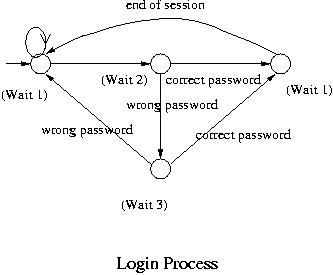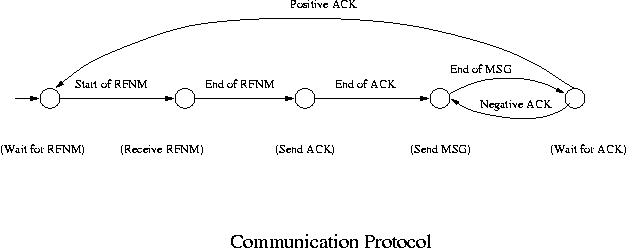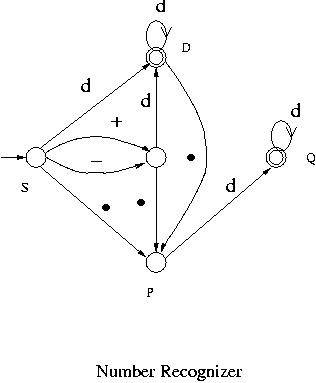Some of the systems operating in practice can also be modeled by finite automata such as control circuits of computers, computer network communication protocols, lexical analysers for compilers etc. Many of those systems fall into the class of systems called reactive system. A reactive system is a system that changes its actions, outputs and conditions/status in response to stimuli from within or outside it. It is an event driven or control driven system continuously having to react to external and/or internal stimuli. The inputs for a reactive system are never ready unlike for example when two numbers are added together by an adder (Here we are considering an adder at a higher level of abstraction than physical devices level ignoring for example the transient states of the electronic circuit that realizes an adder). An adder does not respond unless the input i.e. two numbers to be added are ready. A system such as an adder is called a transformational system. In the case of vending machine or communication protocol, on the other hand, a system must respond to each stimulus, even to a fragment of input such as each coin tossed in for a can of soda or every message received.
It is generally agreed that finite automata are a natural medium to describe dynamic behaviors of reactive systems. Finite automata are formal and rigorous and computer programs can be easily written to simulate their behaviors.
To model a reactive system with finite automaton, first the states the system goes in or the modes of its operation are identified. These become the states of the finite automaton that models it. Then the transitions between the states triggered by events and conditions, external or internal to the system, are identified and they become arcs in the transition diagram of the finite automaton. In addition actions that may take place in those states can also be added to the model.
For example consider the following very simplified version of login process to a computer from the computer point of view. Let us assume for simplicity that this computer accepts a single user at a time.

Initially the computer waits for a user name to be typed in. This is one state of the system. When a name is typed in, it checks whether or not the name is valid. If it is valid, then it asks for and then waits for the password, which is another state. If the user name typed in is not valid, it goes back to the initial state. We could make it go to a different state and count the number of login attempts for security purpose. But let us make it simple. When a password is typed in and it is correct, then it accepts the user and starts a session. That is another state though it could further be broken down into a number of more states. When the session terminates, it gets a signal, goes back to the initial state and waits for another login. If the password typed in is incorrect, then it informs the user of that and waits for the next try. That is a fourth state. If the second password fails, it goes to the initial state and starts all over again. Again what we have seen is a model for one level of abstraction. Depending on how much detail we are interested in, different states would be identified and transitions would have to be selected accrdingly.
The next example is a protocol for a computer to follow in communicating with another computer. Again it is a very simplified version.

Initially the computer is in wait state waiting for "Request for Next Message" (RFNM) to come from another computer. When a RFNM starts coming, it goes into the state of receiving it (Our interpretation is that the computer is in a state of receiving an RFNM and it is taking the action of receiving the RFNM) . Upon completion of the RFNM, it sends "Acknowledgement" (ACK) to the other computer, which is another state. After sending the ACK, it starts sending the requested message to the other party. When it is complete, it goes into another wait state waiting for an ACK to come from the other computer. If a negative ACK is received, it resends the message. If a positive ACK is received, it goes back to the initial state and waits for another RFNM to come. Thus a finite automaton that models this protocol has the following five states: initial state (wait for RFNM), receiving RFNM, sending ACK, sending message and waiting for ACK.
Again depending on the level of abstraction, different states and transitions would have to be chosen.
Our third example is a system that recognizes numbers with or without a sign such as 5.378, -15, +213.8 etc. One such system initially waits for the first symbol to come in. If the first symbol is a sign, then it goes into a state, denote it by G, that indicates that a sign has been received.
If the first digit is received before a decimal point, regardless of whether a sign has been read or not, it goes into a state, denote it by D, that indicates a digit has been read before a decimal point.
If a decimal point is received before a digit, then it goes into a state, denote it by P, that indicates that a decimal point has been read.
If a decimal point has been read (i.e. in state P), then it must receive at least one digit after that. After one digit it can continue receiving digits. Therefore from state P it goes to another state, denote it by Q, after reading a digit and stays there as long as digits are read. This Q is an accepting state.
On the other hand if a digit has been read before a decimal point, i.e. it is in state D, then it can continue receiving digits and stay in D. D is another accepting state. If a decimal point is read while in D, then it goes to state P indicating that a decimal point has been read.
This system can also be described by a regular expression.
Since these numbers are represented by strings consisting of a possible sign, followed by zero or more digits, followed by a possible decimal point, followed by one or more digits, they can be represented by the following regular expression:
( s+ + s- + ) ( d+.d+ + d+ + .d+ ),
) ( d+.d+ + d+ + .d+ ),
where s+ and s- represent the positive and negative signs, respectively and d { 0 , 1 , 2 , . . . , 9 } . This system can be modeled by the following finite automaton:
{ 0 , 1 , 2 , . . . , 9 } . This system can be modeled by the following finite automaton:

LEXICAL ANALYSIS:-
The state controlling function is equally obvious.
Here, in the second table, "start" is an abbreviation for "possible start of comment", "inside" is an abbreviation for "inside comment", and so on. The reader is requested to try his/her hand at implementing the above finite automaton in some standard computer language like C or ForTran.
It is generally agreed that finite automata are a natural medium to describe dynamic behaviors of reactive systems. Finite automata are formal and rigorous and computer programs can be easily written to simulate their behaviors.
To model a reactive system with finite automaton, first the states the system goes in or the modes of its operation are identified. These become the states of the finite automaton that models it. Then the transitions between the states triggered by events and conditions, external or internal to the system, are identified and they become arcs in the transition diagram of the finite automaton. In addition actions that may take place in those states can also be added to the model.
For example consider the following very simplified version of login process to a computer from the computer point of view. Let us assume for simplicity that this computer accepts a single user at a time.

Initially the computer waits for a user name to be typed in. This is one state of the system. When a name is typed in, it checks whether or not the name is valid. If it is valid, then it asks for and then waits for the password, which is another state. If the user name typed in is not valid, it goes back to the initial state. We could make it go to a different state and count the number of login attempts for security purpose. But let us make it simple. When a password is typed in and it is correct, then it accepts the user and starts a session. That is another state though it could further be broken down into a number of more states. When the session terminates, it gets a signal, goes back to the initial state and waits for another login. If the password typed in is incorrect, then it informs the user of that and waits for the next try. That is a fourth state. If the second password fails, it goes to the initial state and starts all over again. Again what we have seen is a model for one level of abstraction. Depending on how much detail we are interested in, different states would be identified and transitions would have to be selected accrdingly.
The next example is a protocol for a computer to follow in communicating with another computer. Again it is a very simplified version.

Initially the computer is in wait state waiting for "Request for Next Message" (RFNM) to come from another computer. When a RFNM starts coming, it goes into the state of receiving it (Our interpretation is that the computer is in a state of receiving an RFNM and it is taking the action of receiving the RFNM) . Upon completion of the RFNM, it sends "Acknowledgement" (ACK) to the other computer, which is another state. After sending the ACK, it starts sending the requested message to the other party. When it is complete, it goes into another wait state waiting for an ACK to come from the other computer. If a negative ACK is received, it resends the message. If a positive ACK is received, it goes back to the initial state and waits for another RFNM to come. Thus a finite automaton that models this protocol has the following five states: initial state (wait for RFNM), receiving RFNM, sending ACK, sending message and waiting for ACK.
Again depending on the level of abstraction, different states and transitions would have to be chosen.
Our third example is a system that recognizes numbers with or without a sign such as 5.378, -15, +213.8 etc. One such system initially waits for the first symbol to come in. If the first symbol is a sign, then it goes into a state, denote it by G, that indicates that a sign has been received.
If the first digit is received before a decimal point, regardless of whether a sign has been read or not, it goes into a state, denote it by D, that indicates a digit has been read before a decimal point.
If a decimal point is received before a digit, then it goes into a state, denote it by P, that indicates that a decimal point has been read.
If a decimal point has been read (i.e. in state P), then it must receive at least one digit after that. After one digit it can continue receiving digits. Therefore from state P it goes to another state, denote it by Q, after reading a digit and stays there as long as digits are read. This Q is an accepting state.
On the other hand if a digit has been read before a decimal point, i.e. it is in state D, then it can continue receiving digits and stay in D. D is another accepting state. If a decimal point is read while in D, then it goes to state P indicating that a decimal point has been read.
This system can also be described by a regular expression.
Since these numbers are represented by strings consisting of a possible sign, followed by zero or more digits, followed by a possible decimal point, followed by one or more digits, they can be represented by the following regular expression:
( s+ + s- +
 ) ( d+.d+ + d+ + .d+ ),
) ( d+.d+ + d+ + .d+ ), where s+ and s- represent the positive and negative signs, respectively and d
 { 0 , 1 , 2 , . . . , 9 } . This system can be modeled by the following finite automaton:
{ 0 , 1 , 2 , . . . , 9 } . This system can be modeled by the following finite automaton: 
LEXICAL ANALYSIS:-
A concrete application : Lexical analysis
Consider a huge C-code with lots of embedded comments. As the reader should know already, C-comments are delimited by a starting/* and a trailing */, and comments cannot be nested. When a compiler reads the code it strips all the comments off the code. How is this stripping done? To understand this we shall write a that portion of the compiler which strips comments. Our compiler will read the program file character by character. Since the program may be very huge, it makes no attempt to store huge chunks of the code at a time. Keeping this restriction in mind we know that our compiler (which will presently emerge as a finite automaton) has input set consisting of all the possible characters that may be present in C code. Now let us delve into the mind of the compiler. When it starts reading the file it is outside any comment. It goes on reading character after character from the file (and tossing the characters in the output file) until it meets the first /. Then it knows that t has encountered a possible start of comment. To make sure it reads the next character. If it is a * then the compiler is certain that it is inside a comment. In this case the compiler keeps on reading the file, but now throws away the characters in the garbage bin. If it was not a * then of course the compiler understands that it is outside any comment and keeps on copying the characters read into the output file. In our imaginary voyage through the mind of the compiler, let us again imagine ourselves in the situation where the compiler is inside a comment. If it happens to meet a * it knows that it may be a possible end of comment. So after trashing the * it reads the next character. If it is a / then the comment has indeed ended and the compiler is again in a region that is outside any comment. Let us take one more look at the above confusing description paying particular attention to the bold phrases. There are four of them:
outside any comment
possible start of comment
inside a comment
possible end of comment
* or / or something else. But is that all? Not quite! Our automaton needs some way to know when the end of file has been reached. You surely cannot leave the machine to imitate poor Oliver, "always asking for more"! So we need another special input symbol which we shall call EOF (End Of File). Thus we shall have four inputs:
EOF
<anything else>
*
/
PC : Print the Currently read character in the output file
T : Trash the currently read character
S: Store the currently read character in a temporary storage.
D : issue the message "Done".
E : issue the message "Error".
PSC : Print the Stored character followed by the Current character.
PSD : Print the Stored character and say "Done".
| Inputs | ||||||||||||||||||||||||||
|---|---|---|---|---|---|---|---|---|---|---|---|---|---|---|---|---|---|---|---|---|---|---|---|---|---|---|
| States |
|
| Inputs | ||||||||||||||||||||||||||
|---|---|---|---|---|---|---|---|---|---|---|---|---|---|---|---|---|---|---|---|---|---|---|---|---|---|---|
| States |
|

No comments:
Post a Comment